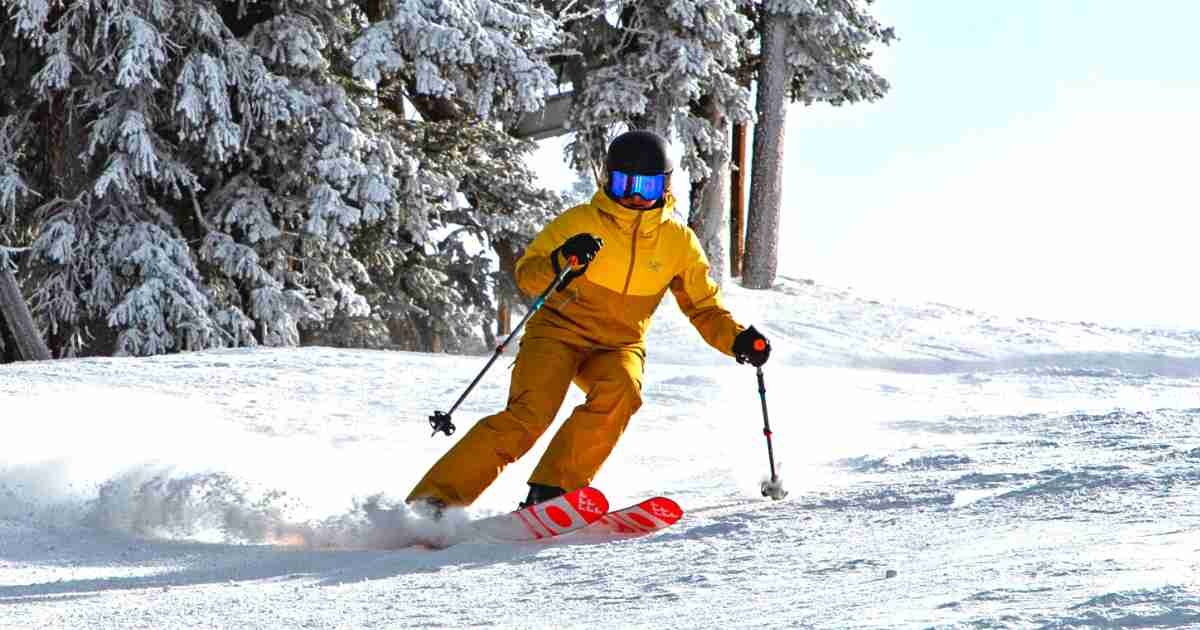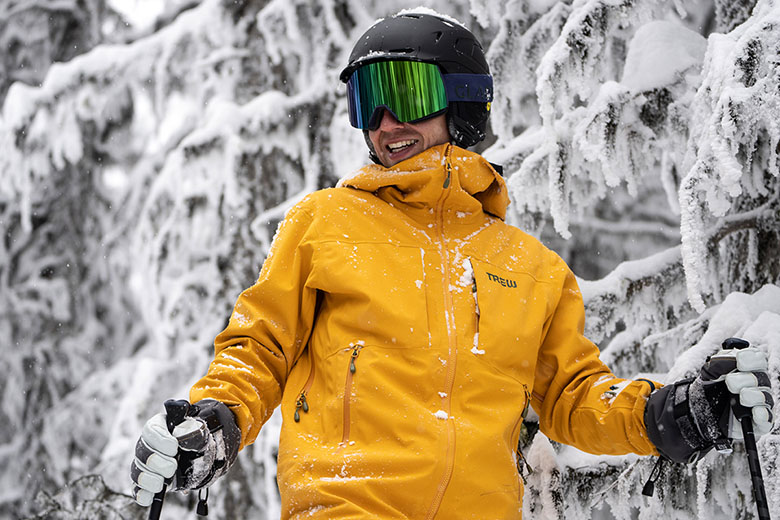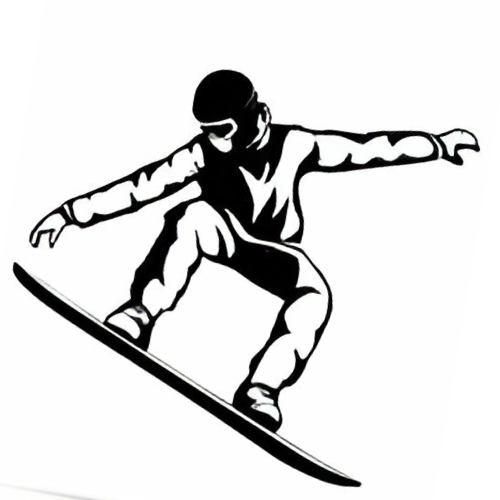For skiing, typically you wear three layers: a base layer, an insulating middle layer, and a waterproof outer layer. Choosing the right materials for these layers is crucial for warmth and mobility.
Skiing necessitates proper attire to stay warm and dry on the slopes. Your base layer should be moisture-wicking to keep sweat away from your skin, either made of synthetic fabrics or merino wool. The middle layer, focused on insulation, often consists of fleece or down, providing the necessary warmth without excessive bulk.
The outer layer is your shield against the elements; a quality, breathable yet waterproof ski jacket and pants are indispensable. This three-layer system can be adjusted to suit weather conditions, activity level, and personal comfort, ensuring that you spend more time enjoying the slopes and less time worrying about the cold. Remember, your choice in ski wear can make or break your day on the mountain.
Gearing Up For The Slopes
Dressing right for skiing ensures warmth and mobility. Your layers must work together to trap body heat and remove moisture. Many skiers wonder what to wear once they hit the slopes. It’s not just about piling on clothes; it’s about clever layering. Let’s dive into how to select the best ski attire, layer by layer.
Choosing The Right Base Layer
The base layer is your first line of defense against the cold. It sits right against your skin. A good base layer will keep you dry by moving sweat away. Here are key points to consider for a base layer:
- Material: Look for synthetic or wool fabrics.
- Fit: It should be snug but not too tight.
- Weight: Options vary from lightweight to heavy; choose based on activity level and weather.
Importance Of Fabric Technology
Next, think about fabric technology. Not all materials are equal when you’re braving the cold. Here are elements that make or break ski wear:
| Fabric Feature | Benefit |
|---|---|
| Moisture-wicking | Keeps skin dry, reducing chills. |
| Insulation | Traps heat to maintain body temperature. |
| Breathability | Allows moisture to escape, preventing overheating. |
Remember, the right fabric can make a difference in comfort and performance. Advanced fabrics like Gore-Tex and Thinsulate provide top-notch insulation and breathability. They are worth the investment for serious skiers.

Credit: www.treelinereview.com
The Art Of Layering
When preparing for a day on the slopes, understanding how to effectively layer clothing is crucial. The art of layering for skiing involves combining different types of clothing to maintain warmth, manage moisture, and shield from harsh weather conditions. Proper layering allows skiers to stay comfortable and dry from the inside out.
Thermal Dynamics And Body Heat
Generating and retaining body heat lies at the core of successful layering. The body naturally produces heat during physical activity, like skiing. The key is to trap this warmth while allowing excess moisture to escape.
- Base Layer: Wear moisture-wicking fabrics close to your skin.
- Mid Layer: Add a light or medium fleece for insulation.
- Outer Layer: Use a breathable, waterproof jacket to protect against wind and snow.
This trio works together to regulate body temperature in varying weather and activity levels.
Balancing Insulation And Ventilation
Finding the right balance between staying warm and avoiding overheating is essential. Ventilation plays a pivotal role in this delicate balance.
| Layer | Function | Material |
|---|---|---|
| Base | Moisture Control | Synthetic, Wool |
| Mid | Heat Retention | Fleece, Down |
| Outer | Elemental Protection | Gore-Tex, Nylon |
Items like zippered jackets and vented pants allow skiers to release heat as needed. Additionally, peeling off a layer or adding one can tailor comfort levels efficiently.
Mid-layer Mastery
When skiing, mastering your mid-layer is vital for warmth and comfort on the slopes. This layer traps the heat your base layer has worked so hard to maintain. It’s also easy to shed if temperatures rise. Let’s dive into what makes for the perfect mid-layer and explore the materials and features to consider.
Fleece Vs. Down Vs. Synthetic Options
Fleece, down, and synthetic insulators are the big three in mid-layer materials. Each offers unique benefits.
- Fleece is soft, breathable, and dries quickly. It’s great for active skiers who need moisture management.
- Down provides excellent warmth-to-weight ratio but struggles when wet. It’s perfect for cold, dry days.
- Synthetic insulation mimics down but excels in damp conditions. For unpredictable weather, it’s a reliable choice.
Zippered Garments For Temperature Control
Zippered mid-layers give you the power to regulate your body temperature. Open the zip when you’re hot; close it to trap heat when cold. Look for jackets with chest and underarm vents for the best control.
| Feature | Benefit |
|---|---|
| Full Zip | Easy on and off; total temperature control |
| Half Zip | Lightweight; offers some temperature regulation |
| Vents | Targeted cooling without removing layers |
Choose a mid-layer with a zipper that matches your activity level and weather conditions.

Credit: www.switchbacktravel.com
Outer Layer Strategies
Outer Layer Strategies are vital when gearing up for skiing. Picking the right outer layers means staying dry, warm, and comfortable on the slopes. A successful day on the mountain depends on these choices. Let’s dive into the essentials of waterproofing, windproofing, and the features to seek in ski-ready outerwear.
Waterproofing And Windproofing Essentials
The right outer layer shields you from the elements. This means no water or wind gets through. A waterproof jacket and pants are non-negotiable. Look for items with a high waterproof rating. The rating shows how well fabric keeps water out. Windproofing is just as crucial. A fierce wind can cut through layers and chill you to the bone. Trust in materials that block wind to maintain warmth.
- Waterproof Rating: Choose gear with at least 10,000mm waterproofing.
- Windproof: Ensure the outer layer is also wind-resistant.
- Seams: Sealed or taped seams prevent water seeping in.
Features To Look For In Ski Jackets And Pants
Your outerwear should work for you. Functionality teams up with comfort to boost your skiing experience. Let’s spotlight the must-have features:
| Feature | Benefit |
|---|---|
| Ventilation Zippers | Release excess heat without removing layers. |
| Powder Skirt | Prevents snow from entering your jacket. |
| Adjustable Cuffs | Creates a snug fit with gloves. |
| Reinforced Areas | Adds durability to high-wear zones. |
| Pockets | Keep essentials handy and secure. |
Choose ski jackets and pants with these features. They will make your skiing days better. Balanced layers mean you focus less on the cold and more on the thrill.
Accessorize For Warmth And Function
When preparing for a day on the slopes, it’s crucial to accessorize smartly. Both warmth and function are essential when choosing your skiing accessories. Proper gear can make all the difference in your comfort and performance. So, what are the best options?
Gloves Vs. Mittens
Choosing between gloves and mittens is vital for hand comfort and warmth. Gloves offer more dexterity, allowing for better grip and control. They’re great for tasks like adjusting bindings. However, mittens keep fingers together, preserving heat more effectively. They’re the top choice in frigid temperatures.
- Gloves: Better for movement and tasks
- Mittens: Warmer for colder conditions
The Role Of Goggles And Face Masks
Goggles and face masks play a big role in skiing comfort. Goggles protect your eyes from wind, snow, and UV rays. Always choose goggles with a good anti-fog system to ensure clear vision. A face mask provides much-needed protection from the cold, shielding your face from sub-zero wind chills.
| Accessory | Function |
|---|---|
| Goggles | Eye protection and clear vision |
| Face Mask | Keeps face warm and guards against wind |
Fine-tuning With Tech
Fine-Tuning with Tech is essential for comfort on the slopes. As skiing pushes your body to extremes, it is vital to wear the right amount of layers. Technology steps in to offer solutions. Heated apparel and smart clothing regulate your body temperature. This ensures your focus stays on the thrill of skiing.
Heated Apparel: Pros And Cons
Heated clothing takes comfort to the next level. Items like heated jackets and socks keep you warm using rechargeable batteries. Let’s look at the benefits and drawbacks:
- Pros:
- Provides consistent heat
- Adjustable temperature settings
- Enhances overall warmth
- Reduces the need for multiple layers
- Cons:
- Requires charging
- Can be expensive
- Potential for technical issues
- Heavier than traditional layers
Smart Clothing For Temperature Regulation
Smart clothing incorporates technology directly into fabric. Sensors adjust the temperature based on your body’s needs. This is how it works:
| Sensor Type | Function |
|---|---|
| Thermal Sensors | Monitor body heat |
| Moisture Wicking | Keep skin dry |
| Adaptive Heating | Adjust warmth as needed |
Smart clothing offers a dynamic way to stay warm, responding to activity levels and outside temperatures. The benefits are clear, but there are also considerations to keep in mind:
- Pros:
- Adapts to changing conditions
- Saves energy by targeting warmth
- Improves overall skiing experience
- Cons:
- More costly than traditional gear
- May require special care
- Limited styles available
Special Considerations
Wearing the right number of layers for skiing is crucial. It keeps you warm and dry on the slopes. But not all skiing conditions or skiers are the same. Special considerations must take place. This includes understanding extreme weather and knowing how to dress children or beginners. Let’s dive into the specifics.
Dressing For Extreme Conditions
‘Extreme conditions’ mean very cold or windy weather. In these cases, you need more than the usual three layers. Start with a thermal base layer to keep warmth. Add a fleece as the mid-layer, and never forget a waterproof and windproof outer layer. Here are key points:
- Thermal Base Layer: Go for materials that wick away moisture.
- Insulating Mid-Layer: Fleece or down jackets are best.
- Protective Outer Layer: It should resist wind and water.
- Accessories: Don’t overlook gloves, a hat, and thermal socks.
Always check the weather forecast before you head out. Adjust your layers accordingly.
Layering Tips For Children And Beginners
Children and skiing neophytes feel the cold more than seasoned adults. Beginners should focus on extra warmth. Use these tips:
- Start with a snug base layer that manages moisture.
- Add an extra mid-layer on colder days.
- The outer layer should be easy to remove.
Remember: Comfort brings confidence on the slopes. Ensure they can move freely. Use layers that zip or Velcro, so adjustments come easy. Have kids take breaks to avoid them getting too cold or too sweaty. Balance is key—too many layers may restrict movement and cause overheating.
Safety and comfort are vital for a great skiing experience. Dress correctly and hit the slopes with confidence.
Adapting To Your Environment
Choosing the right clothing for skiing is like creating a masterpiece. It’s all about layering. Skiing conditions can change in the blink of an eye. One minute you’re carving down powdery slopes under a clear blue sky, and the next you’re shrouded in a chilly mist. Adapting to your environment is key to staying warm, dry, and comfortable on the slopes.
Adjusting Layers During The Day
When the sun peaks, it might get warm. Being prepared means you can adjust:
- Mornings can be crisp, demanding thermal layers.
- Midday might call for shedding a layer.
- Evening temps drop, so add them back.
A breathable, moisture-wicking base layer will keep you dry. A mid-layer, such as a fleece, provides insulation. The top layer should be a waterproof, breathable shell jacket.
Zippers are friends! Use them for quick ventilation adjustments.
Prepping For Diverse Ski Resorts And Altitudes
Different elevations mean different weather patterns. Research is crucial.
- Check the expected temperatures.
- Be aware of the resort’s altitude.
- Look at the weather forecast.
High altitudes are colder and might need an extra mid-layer. Coastal resorts may require waterproofing due to wetter snow. Always common: a good pair of sunglasses and sunscreen.
Your goal: Balance between warm and cool. You want to avoid sweat and shivers. Smart layering makes it happen.
Remember, every skier is unique. It’s about finding what works for you. Keep adjusting until you hit the sweet spot – where the cold doesn’t bother you, and you’re as snug as a bug in a ski rug!
Layering Missteps To Avoid
Layering Missteps to Avoid when preparing for a day on the slopes is crucial for comfort and safety. Too many layers or the wrong materials can spoil the fun. Let’s explore common errors skiers make and learn the right techniques.
Common Overlayering Pitfalls
Skiers often think “the more, the merrier” when it comes to layers. But too much can lead to sweating which then freezes. This can make you cold. It’s tricky to find the balance, so here are pitfalls to avoid:
- Ignoring the fabric: Not all materials are equal for warmth and breathability. Choose wisely.
- Not considering activity level: Layer based on how hard you’ll ski. More activity means fewer layers.
- Forgetting to adjust: Weather changes, so should your layers. Shed or add as needed.
Understanding Moisture Management
The key to staying warm is staying dry. Managing moisture is vital, and here’s how:
| Layer | Function |
|---|---|
| Base layer | Wicks sweat away from your body. |
| Mid layer | Provides insulation and continues moisture transfer. |
| Outer layer | Shields against wind and water while allowing vapor to escape. |
Remember, materials like wool or synthetics work best for a base layer. Avoid cotton as it traps moisture.
Maintenance And Care
The right number of layers can make or break your day on the slopes.
Maintenance and care of your ski apparel ensures comfort and performance.
Here are some essential tips.
Proper Storage Of Ski Apparel
When the ski season wraps up, proper storage is key.
- Let all layers dry thoroughly.
- Avoid damp places for storing clothes.
- Use a cool, dry closet or a storage bin.
Keep them away from heat to prevent damage.
Cleaning Tips For Longevity And Performance
Regular cleaning can extend your gear’s life.
- Follow the manufacturer’s instructions.
- Wash with a gentle, performance-specific detergent.
- Avoid fabric softeners and bleach.
- Close all zippers and fasten Velcro before washing.
Air-drying is often best.
Check for wear and tear before each season.
FAQ
Is 3 Layers Enough For Skiing?
Yes, three layers are generally sufficient for skiing: a base layer for moisture management, an insulating mid-layer, and a waterproof outer layer for protection.
How Many Base Layers Do I Need For A Week Skiing?
For a week of skiing, pack at least three base layers to alternate between while allowing for drying time.
How Many Layers Do You Wear Under Ski Pants?
Typically, wear one to two layers under ski pants: a base layer for moisture-wicking and an optional mid-layer for extra warmth.
How Much Clothes To Wear When Skiing?
Dress in layers for skiing, typically three: a base layer for moisture management, an insulating mid-layer, and a waterproof outer layer. Don’t forget gloves, a hat, and proper ski socks. Adjust these layers based on weather conditions and personal comfort.
Conclusion
Layering up for skiing is all about comfort and performance. Strike a balance; opt for a moisture-wicking base, an insulating mid-layer, and a protective outer shell. Remember, the weather can be fickle, so adjust accordingly and enjoy the slopes safely.
Always prioritize safety and personal preference for an unforgettable skiing experience.
